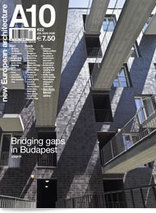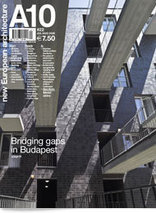Zeitschrift
A10
new European architecture #22
Good intentions
Leo Tolstoy wrote that „all happy families resemble one another, but each unhappy family is unhappy in its own way“. Architects want to make people happy: users, clients, passers-by, perhaps even architecture critics. But architects have an even stronger desire to make something that looks as little as possible like anything else. Those inclined to go along with Tolstoy’s observation, would probably conclude that this is just the very worst route to achieving architectural happiness. Designers, on the other hand, believe that there is no greater architectural happiness than a unique building.
It is entirely to their credit that many architects should want to make the world a better, happier and more harmonious place, although given the permanence and expense of constructing a building, it is really no more than logical. Construction is costly and the lifespan of a building too long for designers not to hope at least for an outcome that feels good. Which perhaps explains why architecture is so far removed from other forms of art like literature, visual art and theatre where there is a much readier acceptance of representations of rootlessness, fear and alienation. They occur in architecture, too – there are enough places that do not make people happy, where people feel uneasy – but this absence of happiness is always an undesirable side-effect, a product of impotence, or simply of unforeseen circumstances.
Obviously, a large part of the built environment suffers from the indifference that attended its creation, but such indifference usually turns out to be more a matter of failure, be it just of the imagination, rather than of evil intent. Perhaps the only exception to this rule is the architectural and urban design cynicism so sadly common in totalitarian states. But most architecture is made with the best of intentions, however counterproductive these occasionally turn out to be.
That kind of counterproductive architecture, not to mention the architecture of indifference, does not appear in architecture magazines, save as a drab, almost interchangeable background against which the happier examples look even more radiant. Which just goes to show that in architecture Tolstoy’s observation about happiness and unhappiness may need to be stood on its head. (Hans Ibelings)
On the spot
News and observations
• Residential harbour developments in Copenhagen (DK)
• European Prize for Urban Public Space to muf’s Barking Town Square in London (UK)
• Helsinki harbour plans cause a stir (FI)
• Will the new Hermitage Guggenheim put Vilnius (LT) on the cultural map?
• Milestone in Serbian social housing (HR)
• Reality check: Palais Thinnfeld, Graz (AT)
• and more...
Start
New projects
• Museum, Gardabaer (IS) by PK Arkitekar
• Oris pavilion, Zagreb (HR) by Andrija Rusan
• Bungee jump platform on water tower, Ploubalay (FR) by Igor Lecomte and Espace Gaïa
• Public centre, Lviv (UA) by Domorinthos
• Hotel, Lernacken (SE) by Space Group
• Department store extension, Graz (AT) by Nieto Sobejano Arquitectos
Interview
Ivan Kucina
Vesna Vucinic interviews Ivan Kucina about the difficulties of being an architect in Serbia. Nevertheless, Kucina remains optimistic: „There is something positive about transition and that is the absence of control.“
Ready
New buildings
• Camping ground, Rimigliano Natural Park (IT) by Archea Associati
• Auditorium and theatre, Villajoyosa (ES) by Jose M. Torres Nadal and Antonio Marquerie
• House, Salzburg (AT) by Flöckner Schnöll Architects
• Social housing, Budapest (HU) by Péter Kis and Csaba Valkai
• Cultural centre, Aarhus (DK) by SLETH Modernism and ET Architecture
• Temporary theatre, Iasi (RO) by Angelo Roventa
• Urban intervention, Bilbao (ES) by ACXT
• School of Economics, Murska Sobota (SI) by Rok Benda, Primoz Hocevar and Mitja Zorc
• Outlet store, Metzingen (DE) by Blocher Blocher
• Town houses, Amsterdam (NL) by Atelier Kempe Thill
• Pavilion, Grammichele (IT) by Marco Navarra
• Cinema, Liège (BE) by architects V+ and engineering firms BAS and B-B
Section
Metal skins
In architecture metal has traditionally been associated with structural properties, with strength, large spans and great heights. Recent decades have seen the development of a new and different approach to the use of metal. Instead of being confined to robust loadbearing structures for utilitarian buildings, steel, aluminium and iron are starting to be used in facades and interiors, including in homes. These are designs which highlight metal’s „softer“ side in subtly worked skins and stylish textiles.
Eurovision
Focusing on European countries, cities and regions
• The power of words: European architectural policy is built on a superabundance of words
• A changing coast: an architectural tour of Croatia
• Profile: Stalker (IT)
• Office: Henning Larsen Architects’ innovative office in Vesterbro, Copenhagen (DK)
Out of Obscurity
Buildings from the margins of modern history
Axel Simon takes us to Eduard Neuenschwander’s 1964 studio in Gockhausen, near Zurich (CH).
Leo Tolstoy wrote that „all happy families resemble one another, but each unhappy family is unhappy in its own way“. Architects want to make people happy: users, clients, passers-by, perhaps even architecture critics. But architects have an even stronger desire to make something that looks as little as possible like anything else. Those inclined to go along with Tolstoy’s observation, would probably conclude that this is just the very worst route to achieving architectural happiness. Designers, on the other hand, believe that there is no greater architectural happiness than a unique building.
It is entirely to their credit that many architects should want to make the world a better, happier and more harmonious place, although given the permanence and expense of constructing a building, it is really no more than logical. Construction is costly and the lifespan of a building too long for designers not to hope at least for an outcome that feels good. Which perhaps explains why architecture is so far removed from other forms of art like literature, visual art and theatre where there is a much readier acceptance of representations of rootlessness, fear and alienation. They occur in architecture, too – there are enough places that do not make people happy, where people feel uneasy – but this absence of happiness is always an undesirable side-effect, a product of impotence, or simply of unforeseen circumstances.
Obviously, a large part of the built environment suffers from the indifference that attended its creation, but such indifference usually turns out to be more a matter of failure, be it just of the imagination, rather than of evil intent. Perhaps the only exception to this rule is the architectural and urban design cynicism so sadly common in totalitarian states. But most architecture is made with the best of intentions, however counterproductive these occasionally turn out to be.
That kind of counterproductive architecture, not to mention the architecture of indifference, does not appear in architecture magazines, save as a drab, almost interchangeable background against which the happier examples look even more radiant. Which just goes to show that in architecture Tolstoy’s observation about happiness and unhappiness may need to be stood on its head. (Hans Ibelings)
On the spot
News and observations
• Residential harbour developments in Copenhagen (DK)
• European Prize for Urban Public Space to muf’s Barking Town Square in London (UK)
• Helsinki harbour plans cause a stir (FI)
• Will the new Hermitage Guggenheim put Vilnius (LT) on the cultural map?
• Milestone in Serbian social housing (HR)
• Reality check: Palais Thinnfeld, Graz (AT)
• and more...
Start
New projects
• Museum, Gardabaer (IS) by PK Arkitekar
• Oris pavilion, Zagreb (HR) by Andrija Rusan
• Bungee jump platform on water tower, Ploubalay (FR) by Igor Lecomte and Espace Gaïa
• Public centre, Lviv (UA) by Domorinthos
• Hotel, Lernacken (SE) by Space Group
• Department store extension, Graz (AT) by Nieto Sobejano Arquitectos
Interview
Ivan Kucina
Vesna Vucinic interviews Ivan Kucina about the difficulties of being an architect in Serbia. Nevertheless, Kucina remains optimistic: „There is something positive about transition and that is the absence of control.“
Ready
New buildings
• Camping ground, Rimigliano Natural Park (IT) by Archea Associati
• Auditorium and theatre, Villajoyosa (ES) by Jose M. Torres Nadal and Antonio Marquerie
• House, Salzburg (AT) by Flöckner Schnöll Architects
• Social housing, Budapest (HU) by Péter Kis and Csaba Valkai
• Cultural centre, Aarhus (DK) by SLETH Modernism and ET Architecture
• Temporary theatre, Iasi (RO) by Angelo Roventa
• Urban intervention, Bilbao (ES) by ACXT
• School of Economics, Murska Sobota (SI) by Rok Benda, Primoz Hocevar and Mitja Zorc
• Outlet store, Metzingen (DE) by Blocher Blocher
• Town houses, Amsterdam (NL) by Atelier Kempe Thill
• Pavilion, Grammichele (IT) by Marco Navarra
• Cinema, Liège (BE) by architects V+ and engineering firms BAS and B-B
Section
Metal skins
In architecture metal has traditionally been associated with structural properties, with strength, large spans and great heights. Recent decades have seen the development of a new and different approach to the use of metal. Instead of being confined to robust loadbearing structures for utilitarian buildings, steel, aluminium and iron are starting to be used in facades and interiors, including in homes. These are designs which highlight metal’s „softer“ side in subtly worked skins and stylish textiles.
Eurovision
Focusing on European countries, cities and regions
• The power of words: European architectural policy is built on a superabundance of words
• A changing coast: an architectural tour of Croatia
• Profile: Stalker (IT)
• Office: Henning Larsen Architects’ innovative office in Vesterbro, Copenhagen (DK)
Out of Obscurity
Buildings from the margins of modern history
Axel Simon takes us to Eduard Neuenschwander’s 1964 studio in Gockhausen, near Zurich (CH).
Weiterführende Links:
A10 Media BV
Artikel








